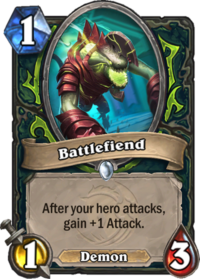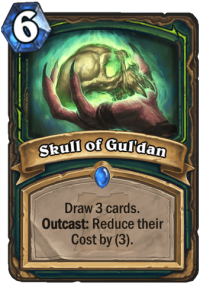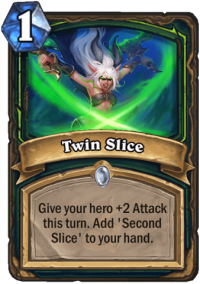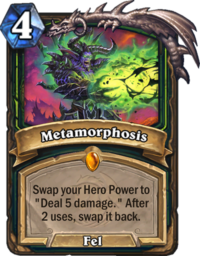Our Tempo Demon Hunter deck list guide goes through the ins-and-outs of this aggressive Demon Hunter deck that has become the most popular archetype for the class! This guide will teach you how to mulligan, pilot, and substitute cards for this archetype!
Introduction to Tempo Demon Hunter

Blizzard’s description of what Demon Hunter feels like is that it is aggressive, fast, and constantly in your face. Tempo Demon Hunter truly lives up to this description as the fastest Demon Hunter archetype. It is basically a pure aggro deck hiding behind a more sophisticated name. At the beginning of Ashes of Outland, Demon Hunter was overpowered, and it was nerfed in record time. This forced the class to look deeper into where its true strengths lie, and it found itself becoming more and more aggressive by the hour.
Tempo Demon Hunter is fast to attack, cycles through the deck at lightning speed and holds many tricks up its sleeves, such as bypassing Taunt minions with Kayn Sunfury, drawing and discounting lots of cards with Skull of Gul'dan with the Outcast bonus, and clearing big boards with Altruis the Outcast.
Tempo Demon Hunter Deck List
At the time I’m writing this guide, there are still several competing Tempo Demon Hunter lists in general use. We will update the list here as time goes on and a consensus on the best build is reached. Currently, most (but not all) lists have dropped the Raging Felscreamer and Priestess of Fury package in favor of more early-game aggression. Furthermore, cards such as Questing Adventurer and Mana Burn are being experimented with.
- 0Tempo Demon Hunter Deck List & Guide – Ashes of Outland – April 20201
- 0Tempo Demon Hunter Deck List & Guide – Ashes of Outland – April 20201
- 0Tempo Demon Hunter Deck List & Guide – Ashes of Outland – April 20202
- 0Tempo Demon Hunter Deck List & Guide – Ashes of Outland – April 20202
- 0Tempo Demon Hunter Deck List & Guide – Ashes of Outland – April 20202
- 0Tempo Demon Hunter Deck List & Guide – Ashes of Outland – April 20202
- 0Tempo Demon Hunter Deck List & Guide – Ashes of Outland – April 20202
- 0Tempo Demon Hunter Deck List & Guide – Ashes of Outland – April 20202
- 0Tempo Demon Hunter Deck List & Guide – Ashes of Outland – April 20202
- 0Tempo Demon Hunter Deck List & Guide – Ashes of Outland – April 20202
- 1Twin Slice2

- 3Satyr Overseer2

- 4Altruis the Outcast1

- 5Glaivebound Adept2

- 6Skull of Gul’dan2

Check out alternative versions of this deck on our Tempo Demon Hunter archetype page!
Tempo Demon Hunter Mulligan Strategy & Guide
VS Fast Decks
Higher Priority (Keep every time)
- Battlefiend – Great one-drop that grows if left unchecked.
- Umberwing – It is like Muster for Battle from the golden days of Paladin. Powerful weapon that allows you to activate attack-based synergies without spending mana.
- Twin Slice – An extremely flexible card that can activate attack-based synergies and remove early threats from the opponent.
- Eye Beam – Formidable defensive tool that can swing aggressive mirrors in your favor.
Lower Priority (Keep only if certain conditions are met)
- Crimson Sigil Runner – Keep if it is the left-most card in your hand so that you can activate its Outcast effect immediately.
- Frenzied Felwing – Keep if you already have early-game threats to get it on the board early.
VS Slow Decks
Higher Priority (Keep every time)
- Battlefiend – Great one-drop that grows if left unchecked.
- Umberwing – Powerful weapon that allows you to activate attack-based synergies without spending mana.
- Satyr Overseer – Good early threat.
Lower Priority (Keep only if certain conditions are met)
- Twin Slice – Keep with Satyr Overseer if you do not have Umberwing.
- Crimson Sigil Runner – Keep if it is the left-most card in your hand so that you can activate its Outcast effect immediately.
- Frenzied Felwing – Keep if you already have early-game threats to get it on the board early.
Tempo Demon Hunter Play Strategy
Your main strategy is to attack relentlessly with your Hero to either deal face damage or to protect your minions that will then deal damage to the opponent. In most matchups, your Health is a resource that you can use liberally to make sure that the opponent remains under pressure. However, do note that if the board is lost, removing the opponent’s minions may no longer be beneficial, and focusing your attacks on their Hero may be preferable.
The Outcast mechanic is powerful and you want to make the most of it. Playing Demon Hunter is also about playing a hand management simulator: you look for ways to activate your Outcast effects by positioning the cards with the keyword as your left-most or right-most card. Most of the time you wiggle them towards the left, but because of your low mana curve, you can sometimes start activating the effects from the right as well. Planning your card use with future turns in mind is especially important when playing as Demon Hunter.

Skull of Gul'dan is your most important Outcast card. You always want to get the discounts for a huge tempo swing, either by playing them immediately on your Skull turn or setting up for a big Altruis the Outcast turn where you play cheap or free cards one after another to repeatedly activate Altruis.
Getting your Skull of Gul'dan to Outcast position is a major priority, and you sometimes want to use other cards ineffectively to ensure that the Skull gets where it is needed. Some of the toughest calls when playing Tempo Demon Hunter are games where victory is in sight on turn six and you need to decide between a big play such as Glaivebound Adept or playing the Skull. Most of the time, playing the Skull is correct.
After the nerfs, there is a peculiar interaction between Skull of Gul'dan and Eye Beam: an Eye Beam discounted to zero by the Skull will actually cost one mana if it is in the Outcast position. This interaction is intentional and something you need to take into account when planning your turns.

Twin Slice is one of the most valuable cards in the deck, do not waste it unnecessarily! It is great for some additional reach, synergy with Altruis, and for activating the effects of Satyr Overseer and Glaivebound Adept without spending any mana. Sometimes you still have to spend it for early removal against other aggressive decks. Note that Twin Slice is not a Twinspell: the Second Slice that you get will be the right-most card in your hand, ready for use with Altruis.
Warglaives of Azzinoth is a remarkable weapon. If you give yourself some damage buffs, you can slice through Taunt minions at ease and still connect to the face at the end. Note that the effect from Warglaives does not require that you have them equipped: you can attack again if you spend the last charge of Warglaives on a minion, and you can even equip another weapon to do so. Each time you attack, you also activate the effects of Battlefiend and Satyr Overseer, making your board that much more dangerous.
Frenzied Felwing can decide games, especially if you can get it on the board early. A one-drop followed by Hero Power and minion attack on turn two can be enough to get the Felwing into play, and most decks do not deal well with an early 3/3 minion, much less two of them.
VS Aggro Decks

Aggro mirrors are a careful dance of board control and determining which one of you is the beatdown. In every game, even in a mirror match, one player is the defender (control) and the other is the attacker (beatdown). You are fast, but you can also control the board, so it is a question of what your opponent can do to punish you if you just go face.
Your main board control tool is your face, not your minions. This can feel scary, but in most games, the aggro deck with the board wins, so you should still use your Health as a resource to gain control of the game. Eye Beam helps considerably, if you can find that.
Frozen Shadoweaver is a powerful tech card for the mirror because you can freeze the opponent’s Hero with it to prevent any attack-based synergies for a turn. It also does a lot of work against Warrior.
VS Control Decks
You are always the beatdown against control decks. It is your job to kill them before they stabilize, and you have some great tricks to enable you to do exactly that.
Initially, you just go in with your Battlefiends, Umberwings, Satyr Overseers, and Frenzied Felwings, and try to end the game immediately.
Mana Burn can be a powerful tech card against control decks because it prevents them from using their removal tools when timed right. Mage looking forward to playing Reno the Relicologist on curve? Well, not with four mana.
If early aggression does not work out, you can stock up for a big Altruis the Outcast turn if you have found that to clear out any minions and deal massive damage to the opponent.

You also have Kayn Sunfury to bypass Taunt minions in the late game. Using Kayn is a judgment call: the 3/5 body can be difficult to remove, so sometimes you just want to play it out for tempo, but against the massive Taunt walls that Priest and especially Druid can build, it can be better to save it for later unless victory is in sight.
Another big card for late-game reach is Metamorphosis. Note that whenever you change your Hero Power, it refreshes. You can use your +1 Attack Hero Power, play Metamorphosis, and use your five damage Hero Power on the same turn. Likewise, on the turn when you use the second charge of Metamorphosis, you can also use your regular Hero Power after it.
Tempo Demon Hunter Card Substitutions
Tempo Demon Hunter includes most of the expensive Demon Hunter cards from Ashes of Outland (Kayn Sunfury, Metamorphosis, and Warglaives of Azzinoth) as well as Frenzied Felwings from the final chapter of Galakrond’s Awakening. However, the deck can also be built on a budget.
Most early-game Demon Hunter cards are good substitutes for the expensive pieces, the replacements depend on the exact list you are currently playing and which ones are already included.
- Questing Adventurers can help find more damage, if you lack any of the key cards.
- Furious Felfin is a good early-game minion.
- Mana Burn can be used to deny tempo from the opponent.
- Consume Magic can be useful to get through Taunt minions if you do not have Kayn.
- Blazing Battlemage is a strong one-drop that can further lower your curve to make the deck even faster.
Leave a Reply
You must be logged in to post a comment.



Old Guardian content is just amazing, I wish he could publish all of his video guides and articles here to gain more audience. He deserves that!
Nice job Old Guardian, thank you 🙂
Guide? Guide!? Lol! You mean play any card you have in hand and maintain a 65%+ WR